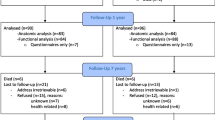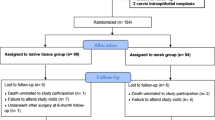Abstract
The aim of this study was to evaluate quality of life, sexual function, and anatomical outcome after posterior vaginal wall prolapse repair using a collagen xenograft. Thirty-three patients were evaluated preoperatively and at 6 and 12 months follow-up (FU). Quality of life and sexual function were assessed using a self-reported questionnaire. Prolapse staging was performed using the pelvic organ prolapse quantification system (POPQ). Preoperatively 3 patients had stage I, 26 patients stage II, and 4 patients stage III prolapse of the posterior vaginal wall. Prolapse of the posterior vaginal wall ≥ stage II was observed in 7 patients (21%) at the 6-month FU and in 13 patients (39%) at the 12-month FU. Mean point Bp was reduced from −1.1 preoperatively to −2.5 at 6 months FU (p<0.01) and −1.8 at 12 months FU (p<0.01). Previous abdominal surgery was associated with a less favorable anatomical outcome (odds ratio: 2.0, 95% confidence interval: 1.5–3.8). There were no significant changes in sexual function or dyspareunia during the 1-year FU. Preoperatively 76% of the patients reported a negative impact on quality of life as a result of genital prolapse. There was a significant improvement in several variables associated with quality of life at 6 and 12 months FU. Posterior vaginal wall prolapse repair using a collagen xenograft was associated with an unsatisfying anatomical outcome at 1-year FU although several quality of life-associated variables affecting psychosocial function were improved. Improvement was not restricted to postoperative restoration of vaginal topography, and previous surgery had a negative effect on anatomical outcome.
Similar content being viewed by others
References
Weber AM, Walters MD, Ballard LA, Booher DL, Piedmonte MR (1998) Posterior vaginal prolapse and bowel function. Am J Obstet Gynecol 179:1446–1449
Bremmer S, Mellgren A, Holmstrom B, Lopez A, Uden R (1997) Peritoneocele: visualization with defecography and peritoneography performed simultaneously. Radiology 202:373–377
Mellgren A, Bremmer S, Johansson C et al (1994) Defecography. Results of investigations in 2,816 patients. Dis Colon Rectum 37:1133–1141
Karlbom U, Graf W, Nilsson S, Pahlman L (1996) Does surgical repair of a rectocele improve rectal emptying? Dis Colon Rectum 39:1296–1302
Hirata H, Matsuyama H, Yamakawa G et al (2004) Does surgical repair of pelvic prolapse improve patients’ quality of life? Eur Urol 45:213–218
Francis W, Jeffcoate T (1961) Dyspareunia following vaginal operations. J Obstet Gynaecol Br Commonw 68:1–10
Weber AM, Walters MD, Piedmonte MR (2000) Sexual function and vaginal anatomy in women before and after surgery for pelvic organ prolapse and urinary incontinence. Am J Obstet Gynecol 182:1610–1615
Miklos JR, Kohli N, Moore R (2002) Levatorplasty release and reconstruction of rectovaginal septum using allogenic dermal graft. Int Urogynecol J Pelvic Floor Dysfunct 13:44–46
Liapis A, Bakas P, Pafiti A, Frangos-Plemenos M, Arnoyannaki N, Creatsas G (2001) Changes of collagen type III in female patients with genuine stress incontinence and pelvic floor prolapse. Eur J Obstet Gynecol Reprod Biol 97:76–79
Cervigni M, Natale F (2001) The use of synthetics in the treatment of pelvic organ prolapse. Curr Opin Urol 11:429–435
Iglesia CB, Fenner DE, Brubaker L (1997) The use of mesh in gynecologic surgery. Int Urogynecol J Pelvic Floor Dysfunct 8:105–115
Bump RC, Mattiasson A, Bo K et al (1996) The standardization of terminology of female pelvic organ prolapse and pelvic floor dysfunction. Am J Obstet Gynecol 175:10–17
FitzGerald MP, Mollenhauer J, Bitterman P, Brubaker L (1999) Functional failure of fascia lata allografts. Am J Obstet Gynecol 181:1339–1344
Soergel TM, Shott S, Heit M (2001) Poor surgical outcomes after fascia lata allograft slings. Int Urogynecol J Pelvic Floor Dysfunct 12:247–253
Kobashi KC, Mee SL, Leach GE (2000) A new technique for cystocele repair and transvaginal sling: the cadaveric prolapse repair and sling (CAPS). Urology 56:9–14
Groutz A, Chaikin DC, Theusen E, Blaivas JG (2001) Use of cadaveric solvent-dehydrated fascia lata for cystocele repair-preliminary results. Urology 58:179–183
Gomelsky A, Rudy DC, Dmochowski RR (2004) Porcine dermis interposition graft for repair of high grade anterior compartment defects with or without concomitant pelvic organ prolapse procedures. J Urol 171:1581–1584
Salomon LJ, Detchev R, Barranger E, Cortez A, Callard P, Darai E (2004) Treatment of anterior vaginal wall prolapse with porcine skin collagen implant by the transobturator route: preliminary results. Eur Urol 45:219–225
Fitzgerald MP, Mollenhauer J, Brubaker L (1999) Failure of allograft suburethral slings. BJU Int 84:785–758
Nygaard I, Bradley C, Brandt D (2004) Pelvic organ prolapse in older women: prevalence and risk factors. Obstet Gynecol 104:489–497
Kelleher CJ, Cardozo LD, Khullar V, Salvatore S (1997) A new questionnaire to assess the quality of life of urinary incontinent women. Br J Obstet Gynaecol 104:1374–1379
Filbeck T, Ullrich T, Pichlmeier U, Kiel HJ, Wieland WF, Roessler W (1999) Correlation of persistent stress urinary incontinence with quality of life after suspension procedures: is continence the only decisive postoperative criterion of success? Urology 54:247–251
Rothbarth J, Bemelman WA, Meijerink WJ et al (2001) What is the impact of fecal incontinence on quality of life? Dis Colon Rectum 44:67–71
Haase P, Skibsted L (1988) Influence of operations for stress incontinence and/or genital descensus on sexual life. Acta Obstet Gynecol Scand 67:659–661
Weber AM, Walters MD, Schover LR, Mitchinson A (1995) Sexual function in women with uterovaginal prolapse and urinary incontinence. Obstet Gynecol 85:483–487
Mouritsen L, Larsen JP (2003) Symptoms, bother and POPQ in women referred with pelvic organ prolapse. Int Urogynecol J Pelvic Floor Dysfunct 14:122–127
Mellgren A, Anzen B, Nilsson BY et al (1995) Results of rectocele repair. A prospective study. Dis Colon Rectum 38:7–13
Kahn MA, Stanton SL (1997) Posterior colporrhaphy: its effects on bowel and sexual function. Br J Obstet Gynaecol 104:82–86
Lopez A, Anzen B, Bremmer S et al (2001) Durability of success after rectocele repair. Int Urogynecol J Pelvic Floor Dysfunct 12:97–103
Rogers RG, Kammerer-Doak D, Villarreal A, Coates K, Qualls C (2001) A new instrument to measure sexual function in women with urinary incontinence or pelvic organ prolapse. Am J Obstet Gynecol 184:552–558
Author information
Authors and Affiliations
Corresponding author
Rights and permissions
About this article
Cite this article
Altman, D., López, A., Gustafsson, C. et al. Anatomical outcome and quality of life following posterior vaginal wall prolapse repair using collagen xenograft. Int Urogynecol J 16, 298–303 (2005). https://doi.org/10.1007/s00192-005-1299-0
Received:
Accepted:
Published:
Issue Date:
DOI: https://doi.org/10.1007/s00192-005-1299-0




